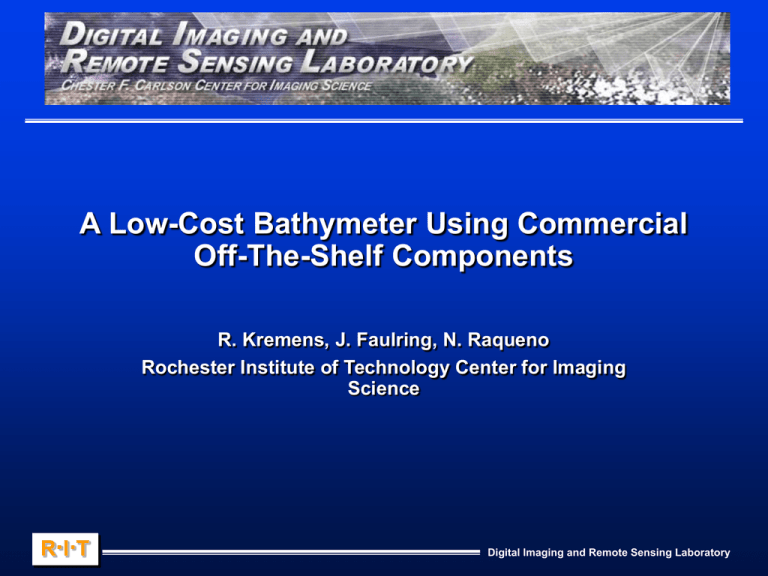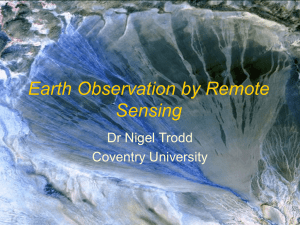A Low-Cost Bathymeter Using Commercial Off-The
advertisement

A Low-Cost Bathymeter Using Commercial Off-The-Shelf Components R. Kremens, J. Faulring, N. Raqueno Rochester Institute of Technology Center for Imaging Science R.I.T Digital Imaging and Remote Sensing Laboratory A Low-Cost Bathymeter Using Commercial Off-TheShelf Components • A Low-Cost Bathymeter Using Commercial Off-The-Shelf Components • R. Kremens, J. Faulring, N. Raqueno • Rochester Institute of Technology Center for Imaging Science • A low cost bathymeter suitable for generation of bottom profile maps of small to mid-size lakes has been developed. The device uses readily available commercial components for depth finding (Garmin Fishfinder 100 depth sounder) and positioning (Garmin GPS eTrex) combined with a custom electronic circuit board that provides data storage and management. Several data acquisition modes (e.g. manual, timed or fixed-distance sampling) are available. Eight analog inputs are also available to measure output from temperature, turbidity, pH or other sensors. The unit is light, waterproof and self-contained and can be deployed from canoes or larger powered vessels. Data from the bathymeter can be automatically downloaded into popular spreadsheet or GIS applications. Measured bottom profile maps from Coneseus Lake, NY will be shown, along with estimates on performance accuracy obtained by comparison with manual soundings. R.I.T Digital Imaging and Remote Sensing Laboratory Depth profiles of small bodies of water are difficult to obtain at low cost/effort • Data for small bodies of water is either missing, old or simply anecdotal • Hydrodynamic/pollution studies require knowledge of lake volume and bottom profiles • Water levels may be affected by seasonal and periodic events (runoff and sedimentation) so frequent re-measurement may be required • Even on large bodies of water (Great Lakes) near-shore data is often missing or inaccurate to shoaling, bottom movement, old data • Design goal: provide a low cost ( < $500) device capable of semiautomatic depth profiling on small lakes ( to 100 m depth) R.I.T Digital Imaging and Remote Sensing Laboratory We have developed a position aware data acquisition module (PADAM) • • The PADAM was developed to acquire data and provide alarms on the wildland fire line The PADAM is a versatile field data recorder: – 8 channel, 12 bit A/D – Precision Thermistor conditioning unit » +/- 0.2 Co absolute temperature measurement – Internal non-volatile memory (64kBytes) – Radio or local (speaker) voice synthesis – 1200 bps RTTY (transmit only) or Packet modem (2-way) – GPS position detection – Commercial radio transceiver fully integrated – Battery life management » Low power modes » Power-down standby R.I.T Digital Imaging and Remote Sensing Laboratory Commercial SONAR hardware added to the PADAM provides depth profiles • We use an inexpensive Garmin Fishfinder 100 to measure depths by SONAR • A Garmin GPS eTrex Legend with wide area augmentation system (WAAS) provides positional accuracy to about 3 meters • Both commercial devices communicate with the PADAM via serial interface – The depth finder and GPS use NMEA 0183 message protocol R.I.T Digital Imaging and Remote Sensing Laboratory A number of other environmental parameters may be optionally recorded using this instrument • Eight analog channels can record turbidity, downwelled radiance, weather parameters (relative humidity, wind direction, speed, barometric pressure) – Enhanced data acquisition planned for this season • We are developing a simple probe to measure pressure (depth) and temperature for determination of thermocline and other depth-temperature features • Precision temperature measurement using YSI thermistor conditioning unit provides surface temperature (at depth transducer) R.I.T Digital Imaging and Remote Sensing Laboratory The instrument is self-contained, water tight and can operate for ~ 3 weeks of ‘data days’ without recharging • Uses NEMA Type 4 waterproof fiberglass housing • Total weight of under 6 pounds makes the unit suitable for kayaks, canoes or larger vessels • Rechargeable gel-cell battery provides 50-70 hours continuous data recording • On-board memory module holds ~ 1850 data points – ~19 hectares at 10 m spatial resolution – Suitable for complete map of small pond – Increased memory >> larger surveyed area R.I.T Digital Imaging and Remote Sensing Laboratory The bathymeter operates in both manual and automatic modes • The device has several data collection modes: – Manual – Records GPS position and depth on command from user – Timed automatic – records GPS position and depth at a pre-determined time interval Data can be acquired at 1 s intervals (limited by GPS readout) – Fixed distance automatic – records position and depth after moving a specified UTM, latitude or longitude R.I.T Digital Imaging and Remote Sensing Laboratory On return to shore, the data is downloaded to a PC using a simple application • Applications developed in MS Visual Basic allow secure downloading with data set description information • Direct import into MS Excel or ArcView GIS application • Can optionally download data to PDA using custom application R.I.T Point # 1 2 3 4 5 6 7 8 9 10 11 12 13 14 15 16 17 18 19 20 21 22 23 24 25 26 27 28 29 30 31 32 33 34 35 36 Longitude Lattitude Depth (m) Time (Z) Date -77.7084 42.7961 0.7 1852 20021109 -77.7084 42.7961 0.9 1852 20021109 -77.7085 42.7964 1.6 1855 20021109 -77.7085 42.7964 1.4 1855 20021109 -77.7093 42.7972 13.1 1902 20021109 -77.7093 42.7972 13.2 1902 20021109 -77.7093 42.7972 13.6 1903 20021109 -77.7111 42.7975 19.2 1913 20021109 -77.712 42.798 21.4 1916 20021109 -77.7119 42.798 15.4 1916 20021109 -77.7111 42.7983 19.1 1918 20021109 -77.7099 42.798 20.8 1921 20021109 -77.7098 42.7981 15.8 1921 20021109 -77.7084 42.7975 12.6 1925 20021109 -77.7086 42.796 0.6 1638 20021120 -77.7087 42.7963 1.4 1643 20021120 -77.7086 42.7967 7.1 1647 20021120 -77.7088 42.7969 9.5 1650 20021120 -77.709 42.7966 9 1653 20021120 -77.7088 42.7967 9 1655 20021120 -77.7092 42.7962 5.4 1659 20021120 -77.7091 42.7962 4.2 1702 20021120 -77.7096 42.7962 8.4 1704 20021120 -77.7098 42.7962 8.8 1704 20021120 -77.7103 42.7961 9.1 1706 20021120 -77.7109 42.7959 5 1710 20021120 -77.7105 42.7959 7.1 1711 20021120 -77.7101 42.7959 7 1713 20021120 -77.7099 42.7957 1.5 1716 20021120 -77.7098 42.7957 1 1718 20021120 -77.7095 42.7957 1 1719 20021120 -77.7092 42.7956 0.7 1720 20021120 -77.7086 42.796 0.8 1723 20021120 -77.7085 42.7959 0.6 1724 20021120 -77.7083 42.796 0.6 1725 20021120 -77.7082 42.7956 0 1735 20021120 Digital Imaging and Remote Sensing Laboratory Results: Near-shore bottom profiling of Conesus Lake, NY • The unit was deployed from a canoe paddled around the shore • Even though this is a relatively large lake, bottom profile is poorly known • USDA runoff investigation requires accurate knowledge of volume, bottom profiles, etc. for hydrodynamic calculations R.I.T Digital Imaging and Remote Sensing Laboratory Results: Near-shore bottom profiling of Conesus Lake, NY (2) • We obtained high-resolution profiles of a stream entrance into the lake • The unit provided very good agreement with conventional (weight sounding) methods – We believe this device is more accurate than hand sampling! •By analyzing the strength of the SONAR return we can provide rudimentary and automatic determination of bottom type (soft, hard, planted) R.I.T Digital Imaging and Remote Sensing Laboratory The unit was able to provide useful depth profiles in the study area in an hour using an unpowered vessel • Study area is a stream outflow into the lake • Using random position, timed sampling acquired about 150 points in one hour with 0.1 m resolution •Bottom map is far superior to what is available from conventional sources R.I.T Digital Imaging and Remote Sensing Laboratory We will incorporate a number of improvements this season • Larger memory (256Kbytes) to allow longer data collection without data downloading • Surface water temperature and turbidity using thermistor and IR scattering cell • Turbidity at depth using weighted probe (10m?) • ‘Vertical’ position sensor using two-axis silicon accelerometer to remove ‘angle effects’ caused by wave action • Ability to add comments to data recording using PDA • All this adds complexity and cost – is it worth it? R.I.T Digital Imaging and Remote Sensing Laboratory






